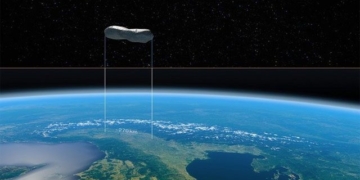Professor Kent Gee, who has dedicated his career to studying high-intensity sounds from rocket launches like NASA’s Artemis I, noted that the sound from the Starship launch has its own unique characteristics.
What would it feel like to witness not just a typical rocket launch, but SpaceX’s Starship, owned by technology billionaire Elon Musk, the largest and most powerful rocket in the world?

The Super Heavy rocket with SpaceX’s uncrewed Starship lifting off from the launch pad in Boca Chica, Texas, USA, on March 14, 2024. (Photo: AFP/TTXVN).
Noah Pulsipher, a student at Brigham Young University (BYU), had the opportunity to witness the Starship launch in October and stated it was undoubtedly the loudest sound he had ever heard. Pulsipher described: “You can feel the sound enveloping your body, sometimes as if it’s pushing you back. Around me, car alarms were going off, dogs were barking loudly; it was truly a powerful and memorable experience.”
Pulsipher is currently a member of the “PASCAL Space Acoustics Laboratory” at BYU, led by Professor Kent Gee. Professor Gee, who has devoted his career to studying high-intensity sounds from rocket launches, remarked that the sound from the Starship launch is distinctly unique.
He shared that the sound features a deep, overwhelming rumble, complemented by sharp high-pitched noises. It is a very special auditory experience.
Not only can it be felt, the sound of the rocket can also be measured scientifically. Pulsipher, Gee, and four colleagues from BYU recently published a study in the JASA Express Letters journal about the noise during the fifth flight of Starship, including the booster landing and sonic booms.

BYU PASCAL research team. (Photo: phys).
The measured results indicate that the sound from the launch is incredibly loud:
- At 10 km away, the noise is comparable to that of a rock concert.
- At 20 km away, the noise levels are similar to those of a table saw or a snow blower.
- At 30–35 km away, the noise remains at levels akin to a vacuum cleaner or a hair dryer.
The study also revealed that a Starship launch produces noise equivalent to 4–6 times that of the Space Launch System (SLS) or at least 10 times that of the Falcon 9 Space Shuttle. As the number of planned Starship launches is expected to increase to 100 times a year, Professor Gee believes that this noise could significantly impact nearby communities.
He noted that the noise could cause windows to rattle, disrupt sleep, trigger alarms, and even affect local wildlife ecosystems. He further explained that while humanity is venturing into space, it is essential to consider how to maintain harmony with the environment. This research will examine the impact on threatened species as well as the community’s quality of life in the area.
Currently, there are no legal guidelines regarding noise levels for rocket launches. Although the PASCAL team’s work does not directly focus on policy, the data from their research may provide valuable information for policymakers and communities as spaceports become more prevalent.
In preparation for Starship’s sixth flight on November 19, the PASCAL team transported three pallets of equipment to Texas, including computers, data collection systems, GPS units, microphones, and windshields. Professor Gee emphasized that this presents a unique opportunity for students to engage in such research and “BYU is the only university studying rocket noise at this level.”
For Pulsipher, the excitement of witnessing a rocket launch never fades. He enthusiastically shared, “It’s always amazing to see a rocket launch. First, you see the flash of light, and then a few seconds later, you hear the sound, and at that moment, you’re left in awe. It’s truly a memorable experience that I always look forward to.”





















































